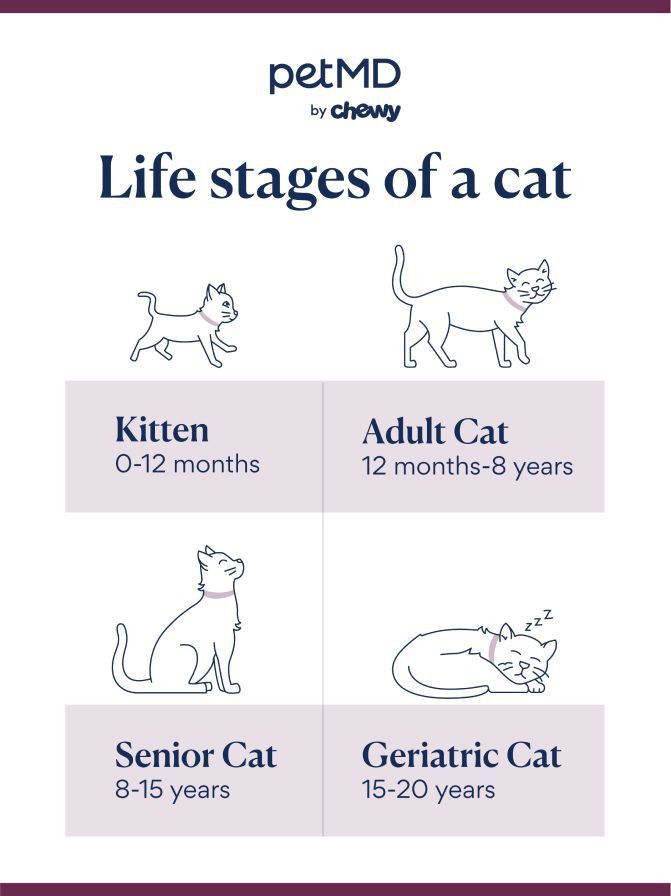Thanks to the progress in veterinary science, improved nutrition, and better overall pet care, our beloved house cats are living longer and healthier lives than ever before. As devoted cat parents, it’s our crucial responsibility to ensure our feline companions reach their golden years in the best possible health. This involves providing tailored care throughout each stage of their lives.
If you’ve ever pondered about your cat’s age in human years or simply wondered, “how long do house cats typically live?”, the answer is multifaceted. It largely depends on the collaborative approach you and your veterinarian take concerning your cat’s nutritional needs, vaccination schedules, dental health, and environmental enrichment as they mature.
This comprehensive guide delves into the average lifespan of house cats, exploring the key determinants and providing actionable insights on how to help your cherished feline companion enjoy a longer, richer life.
Key Insights into Cat Longevity:
- A cat’s diet, consistent preventive healthcare, and whether they are spayed or neutered significantly influence their lifespan.
- Building a strong partnership with your veterinarian is essential to guarantee your cat receives the necessary care for a long and healthy life.
- Promptly consult your vet if you observe any behavioral changes in your aging cat, as these could signal underlying health concerns.
Understanding the Average Lifespan of a Cat
Generally, the average Lifespan Of A House Cat ranges from 13 to 17 years. Remarkably, some cats surpass this average, living for 20 years or even longer. Creme Puff, holding the Guinness World Record as the oldest cat ever documented, lived an astonishing 38 years.
Several interwoven factors dictate a cat’s longevity. Let’s explore these in detail:
-
Nutrition: A diet that’s both complete and balanced is the cornerstone of a cat’s health. It provides the essential nutrients, vitamins, and minerals required for optimal organ function, a robust immune system, and maintaining a healthy body weight. High-quality cat food formulated for their specific life stage (kitten, adult, senior) ensures they receive the right balance of protein, fats, and carbohydrates.
-
Lifestyle: A cat’s lifestyle choices have a profound impact on their lifespan. Indoor cats generally live significantly longer than outdoor cats. This is primarily because indoor environments shield them from numerous hazards, including traffic accidents, predator attacks, exposure to extreme weather, and contagious diseases. Indoor cats also benefit from consistent access to preventative veterinary care.
-
Preventive Care: Proactive healthcare is paramount. Cats that receive all recommended vaccinations and undergo routine health screenings, including blood work, are more likely to have health issues detected and treated early. Regular preventive medications for parasites like fleas, ticks, and heartworms are also crucial in preventing debilitating and potentially fatal diseases transmitted by these pests.
-
Breed Predisposition: Certain cat breeds are genetically predisposed to longer lifespans compared to others. For instance, Siamese cats are often cited as living longer, potentially due to fewer breed-specific health issues, whereas larger breeds like Maine Coons may be prone to conditions related to their size, potentially impacting their longevity.
- Mixed-breed cats often exhibit greater genetic diversity, leading to “hybrid vigor,” which can result in fewer inherited health problems and potentially longer lifespans compared to purebred cats.
- While tabby is a fur pattern and not a breed, tabby cats, particularly domestic shorthair tabbies, are often noted for their robust health and can live for an impressive 15 to 20 years.
-
Genetics: A cat’s genetic makeup plays a significant role. Inherited predispositions to certain diseases can shorten lifespan. Responsible breeders conduct genetic testing to minimize the transmission of hereditary conditions.
-
Spaying and Neutering: Electing to spay or neuter your cat is a decision that profoundly impacts their lifespan. Spayed or neutered cats statistically live longer than intact cats. This is largely attributed to the elimination of risks associated with reproductive cancers and infections, which are more prevalent in unspayed or unneutered animals due to hormonal influences.
Indoor vs. Outdoor Cat Life Expectancy: A Stark Contrast
The disparity in life expectancy between indoor and outdoor cats is significant. Outdoor cats, or those with frequent outdoor access, sadly have an average lifespan that’s roughly half that of their indoor counterparts. Outdoor environments present a multitude of dangers:
- Infectious Diseases: Exposure to feral cats and wildlife increases the risk of contracting contagious diseases like feline leukemia virus (FeLV), feline immunodeficiency virus (FIV), and upper respiratory infections.
- Trauma: Outdoor cats are vulnerable to traumatic injuries from car accidents, attacks by predators (dogs, coyotes, or other wildlife), and territorial fights with other cats.
- Parasitic Infestations: Outdoor cats are more susceptible to infestations of fleas, ticks, ear mites, and intestinal parasites, which can lead to various health complications if left untreated.
 cat life stages; how long do cats live
cat life stages; how long do cats live
Visual representation of cat life stages and approximate age ranges, emphasizing the varying care needs at each stage.
While some cats might benefit from supervised outdoor activities like leash walks or secure outdoor enclosures for mental and physical enrichment, most cats thrive as indoor-only pets when provided with a stimulating and enriched indoor environment.
Indoor-only house cats generally enjoy longer lifespans due to protection from external hazards and consistent access to quality nutrition and veterinary care.
Navigating the Life Stages of Your Cat
As your cat journeys through life, they progress through distinct life stages, each characterized by unique behavioral traits and health requirements. Understanding these stages allows for tailored care to support their well-being at every age.
Kitten Stage (Birth to 1 Year): The Foundation Years
The kitten stage is a period of rapid growth and crucial learning as they explore and interact with their surroundings. This formative phase is vital for establishing a healthy foundation for their future.
While basic habits like litter box training and feeding are often instinctive, socialization and engaging in appropriate play are essential for shaping positive behaviors and mental well-being. Interactive toys and puzzle feeders can stimulate their developing minds and encourage physical activity.
A kitten-specific diet is crucial during this stage. Formulated with higher caloric content and balanced nutrients, it supports their rapid growth and development. Look for cat food labels with an Association of American Feed Control Officials (AAFCO) nutritional adequacy statement indicating “complete nutrition for growing kittens.”
Kittens also require a series of vaccinations to build their immune system and protect them from common feline diseases. Core vaccines like FVRCP (feline viral rhinotracheitis, calicivirus, and panleukopenia), rabies, and FeLV (feline leukemia virus) are typically administered during kittenhood. Spaying or neutering is generally recommended around six months of age to prevent unwanted litters and reduce the risk of certain cancers and undesirable behaviors like urine marking.
Young Adult Stage (1–6 Years): Prime of Life
Young adult cats are energetic and playful, having reached their full physical maturity. Their growth rate slows down, and their caloric needs decrease. Transitioning to adult cat food is necessary to prevent weight gain. Maintaining a healthy weight during this stage is crucial in preventing future health issues like arthritis and diabetes.
Routine veterinary check-ups and maintaining their vaccination schedule remain important, even though young adult cats are generally robust. However, certain conditions like asthma and feline lower urinary tract disease (FLUTD) are more commonly diagnosed during these years. Early detection and management are key to long-term health. Baseline blood work during this stage can establish normal values for future comparisons as they age.
Mature Adult Stage (6–10 Years): Slowing Down Gracefully
Mature adult cats may exhibit a decrease in activity levels, becoming more sedentary. Changes in behavior, such as altered litter box habits or increased nighttime activity, might become noticeable. Some cats may become more vocal or restless at night and sleep more during the day. Changes in litter box behavior, like no longer covering waste or urinating outside the box, can also emerge.
These changes could be indicative of underlying issues like arthritis, cognitive dysfunction, or early stages of kidney or digestive problems. Annual blood work becomes increasingly important for mature cats to monitor kidney, liver, and thyroid function.
Paying close attention to grooming habits, hairball frequency, and weight fluctuations is essential. Oral health also becomes a priority. Regular dental check-ups and professional cleanings, as recommended by your veterinarian, are crucial, especially for cats resistant to home dental care like tooth brushing. Establishing a home dental care routine with cat-friendly toothbrushes and toothpaste is ideal for minimizing the need for frequent professional cleanings and promoting long-term oral health.
Senior Stage (10+ Years): Embracing the Golden Years
The transition to the senior stage is variable; some cats remain active and mobile well into their senior years, while others may experience more age-related health issues. Biannual veterinary check-ups, including blood work and urine testing every six months, are highly recommended for cats aged 10 and above. Organ function can change rapidly in older cats, and early detection of issues is vital.
Senior cats are more prone to conditions like high blood pressure, which can lead to serious complications such as strokes and blindness. Blood pressure monitoring should be a routine part of senior cat check-ups. Reduced activity levels and mobility issues are common in senior cats and may indicate arthritis pain. Joint supplements can be beneficial to support joint health and mobility.
Strategies to Enhance Your Cat’s Lifespan
While we cannot guarantee immortality for our feline companions, there are numerous proactive steps we can take to maximize their lifespan and quality of life:
- Maintain Up-to-Date Vaccinations: Vaccinations tailored to your cat’s lifestyle are critical for preventing preventable infectious diseases. Even indoor cats require core vaccinations to protect them from potential exposures.
- Spay or Neuter Early: Spaying or neutering significantly reduces the risk of life-threatening reproductive diseases and cancers, contributing to a longer and healthier life.
- Commit to Preventative Care: Cats are masters at masking illness. Annual veterinary check-ups and routine blood testing are invaluable for early disease detection. A strong veterinarian-client-patient relationship allows your vet to recognize subtle changes during examinations. Always communicate any behavioral changes you observe, no matter how minor they may seem.
- Adapt Your Cat’s Environment as They Age: As cats age, modifying their environment to accommodate their changing needs is crucial. Discuss joint supplements with your vet if you notice mobility issues. Consider providing orthopedic beds for enhanced comfort and joint support. Ensure easy access to food, water, and litter boxes, potentially opting for low-entry litter boxes for senior cats with mobility limitations.
By proactively addressing your cat’s needs throughout their life stages and partnering with your veterinarian, you can significantly contribute to a longer, healthier, and happier life for your cherished feline companion.
WRITTEN BY
Jamie Lovejoy, DVM
Veterinarian


